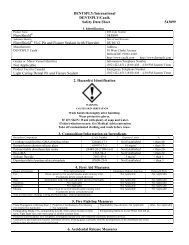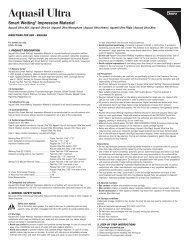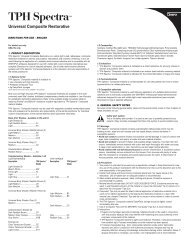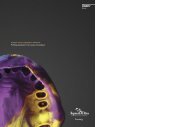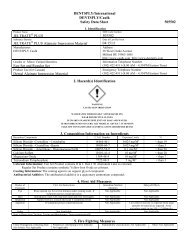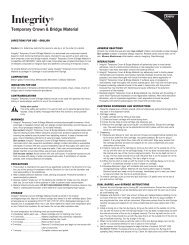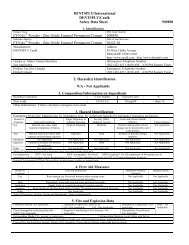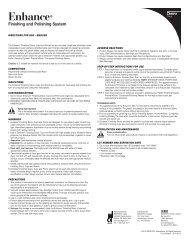Indirect and Direct Restorative Protocols - Caulk
Indirect and Direct Restorative Protocols - Caulk
Indirect and Direct Restorative Protocols - Caulk
Create successful ePaper yourself
Turn your PDF publications into a flip-book with our unique Google optimized e-Paper software.
››Principles & Practices<br />
Accurate Impression Making:<br />
Material Selection <strong>and</strong><br />
Clinical Considerations<br />
››Abstract:<br />
Correct impression capture<br />
is paramount to overall<br />
restorative success. Clinicians<br />
are constantly challenged to<br />
provide clear margins free<br />
from tears <strong>and</strong> voids in order<br />
to allow multiple pours <strong>and</strong><br />
accurate reproduction of the<br />
intraoral environment within<br />
the laboratory. Communication<br />
is enhanced by the use of<br />
predictable materials that<br />
optimize this data transfer<br />
while creating a simplified,<br />
systematic approach designed<br />
for success.<br />
The impression remains the<br />
technician’s most valuable<br />
tool when developing an indirect<br />
restoration. Properly<br />
fitting restorations can only<br />
be fabricated if the dental laboratory is provided<br />
with a precise replica of the existing<br />
intraoral condition. Impression making,<br />
therefore, can be considered the most critical<br />
technique required for data transfer. A<br />
predictable execution of this procedure is<br />
subsequently required to ensure that the<br />
first impression captured is as accurate <strong>and</strong><br />
clear as possible (Figure 1; Table).<br />
As a precursor to the impression procedure,<br />
use of B4® Pre-Impression Surface<br />
Optimizer (DENTSPLY <strong>Caulk</strong>, Milford,<br />
DE) can equalize the surface tension of<br />
multiple substrates (eg, tooth, gingiva,<br />
implant), thereby allowing the impression<br />
material to achieve the desired flowability<br />
<strong>and</strong> detail. Voids <strong>and</strong> bubbles will be minimized<br />
for a more practicable impression,<br />
improving model surface details. A durable<br />
material such as Aquasil Ultra Smart Wetting®<br />
Impression Material (DENTSPLY<br />
<strong>Caulk</strong>, Milford, DE) should then be selected<br />
to avoid tears, distortions, pulls, or drags<br />
in the impression itself. Its ability to adapt<br />
to tooth structures <strong>and</strong> the below the sulcus<br />
enables the practitioner to capture the<br />
details of the intraoral environment. Use of<br />
Aquasil Ultra Smart Wetting® Impression<br />
Material, with its favorable viscosities <strong>and</strong><br />
working time, ensures that the clinician is<br />
able to maintain <strong>and</strong> capture well-defined<br />
margins during the impression procedure<br />
(Figures 2 <strong>and</strong> 3). It can also be delivered<br />
via 50 mL cartridge, the digit® targeted delivery<br />
system (DENTSPLY <strong>Caulk</strong>, Milford,<br />
DE), or DECA 380 mL dynamic mixing<br />
machine cartridge (DENTSPLY <strong>Caulk</strong>,<br />
Milford, DE) according to the preference<br />
of the clinician.<br />
Once the impression is made to the clinician’s<br />
satisfaction, it must demonstrate<br />
Figure 1. Aquasil Ultra Smart Wetting ® Impression Material (DENTSPLY<br />
<strong>Caulk</strong>, Milford, DE) can be used for all indirect restorative procedures.<br />
Figure 2. The dual-cord technique provides gingival retraction <strong>and</strong><br />
hemostasis at the treatment site during impression making.<br />
11



